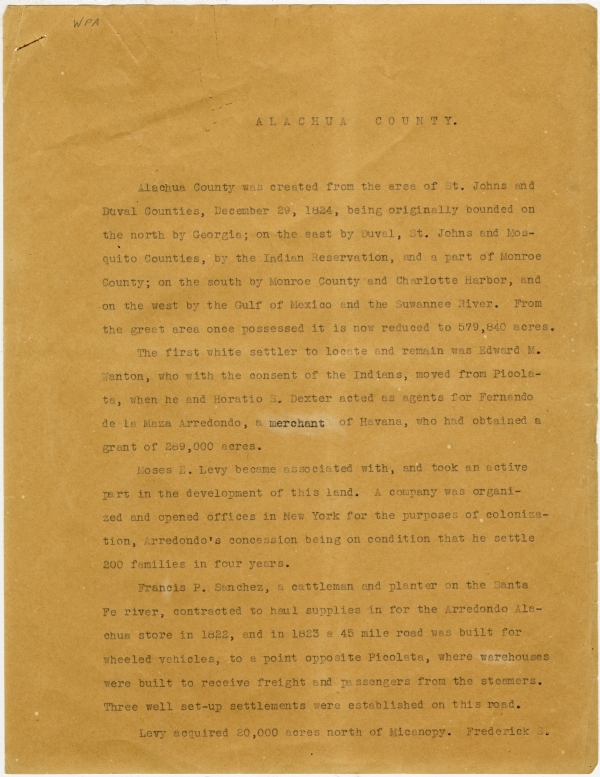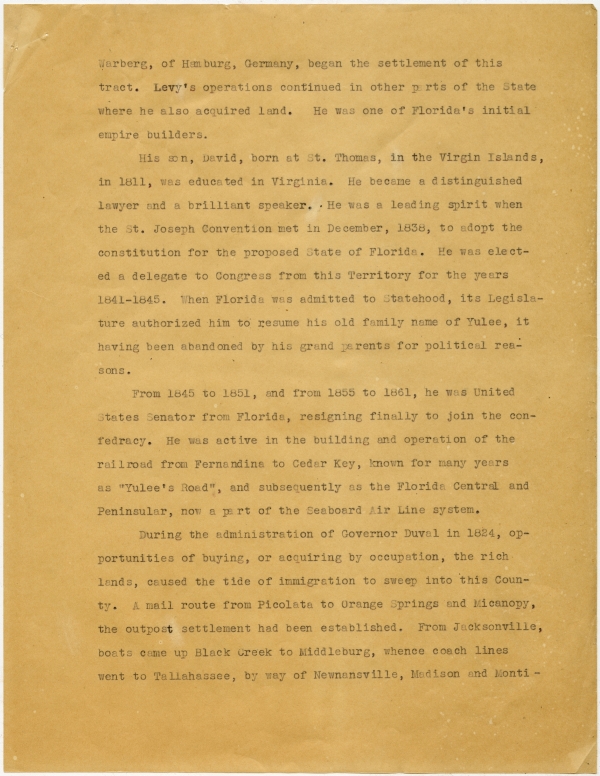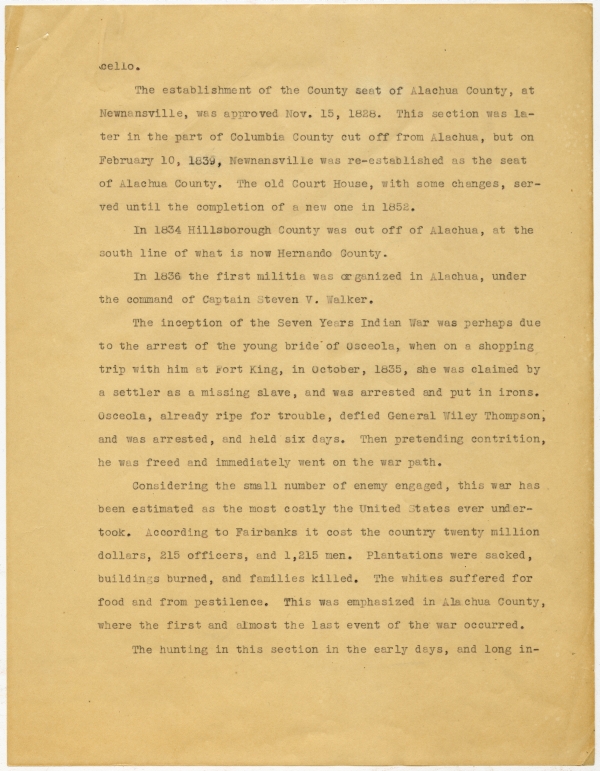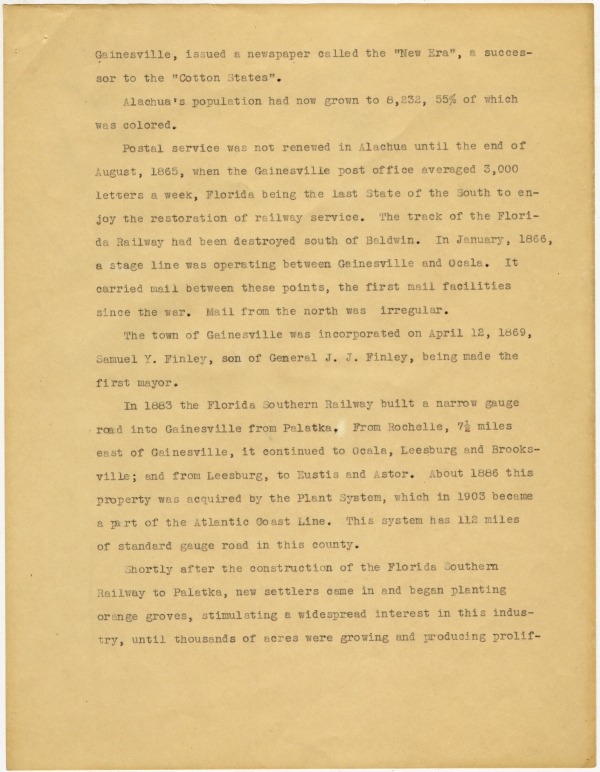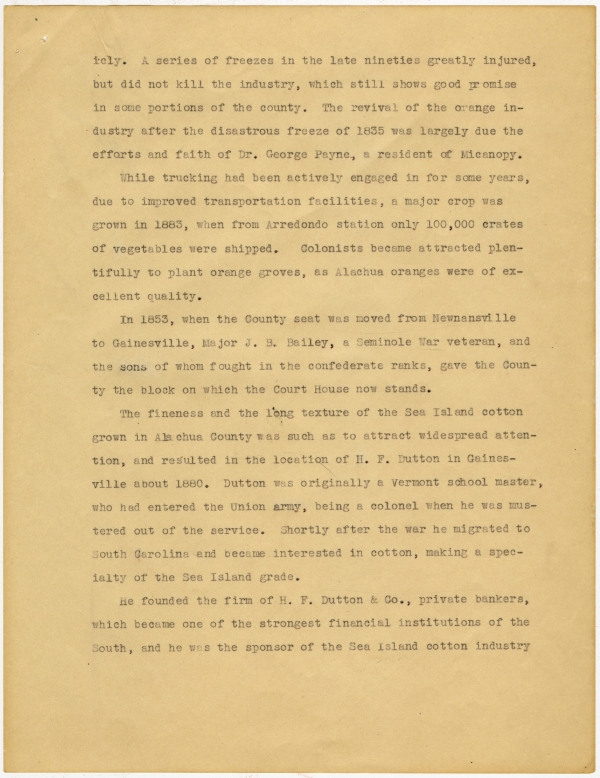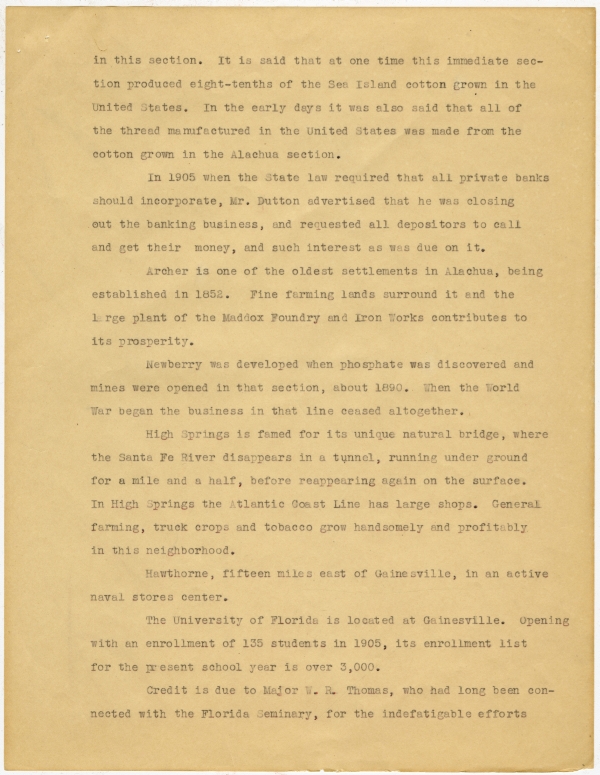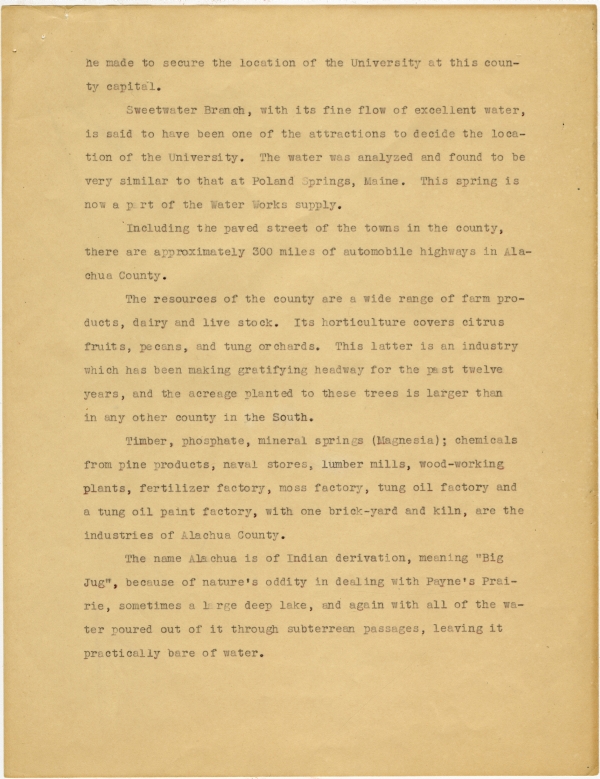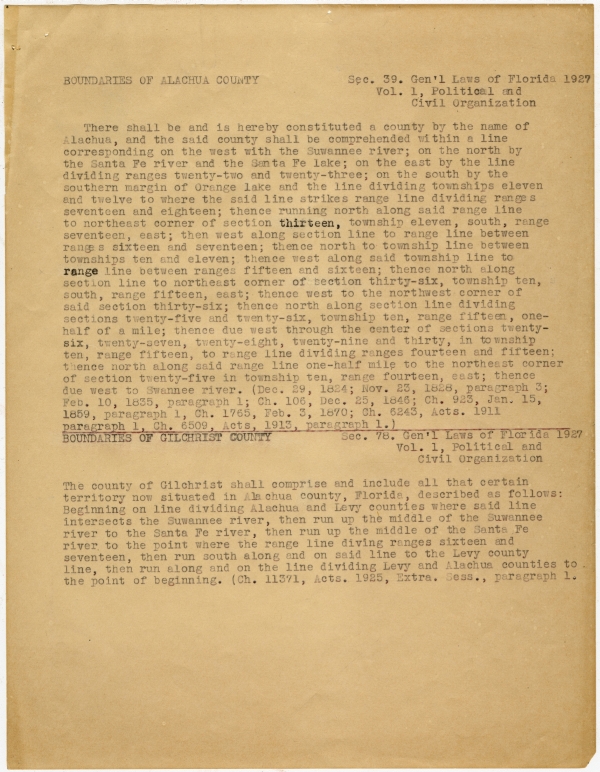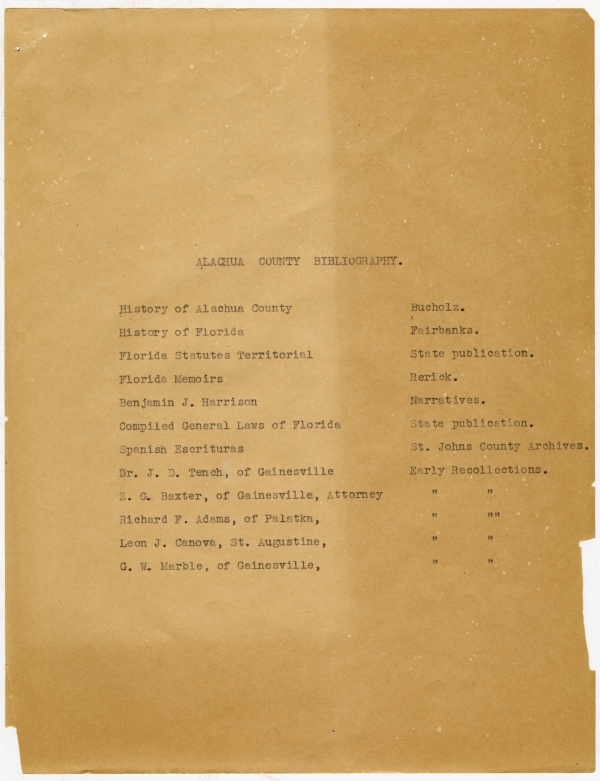Transcript
WPA
ALACHUA COUNTY.
Alachua County was created from the area of St. Johns and Duval Counties, December 29, 1824, being originally bounded on the north by Georgia; on the east by Duval, St. Johns and Mosquito Counties, by the Indian Reservation, and a part of Monroe County; on the south by Monroe County and Charlotte Harbor, and on the west by the Gulf of Mexico and the Suwannee River. From the great area once possessed it is now reduced to 579,840 acres.
The first white settler to locate and remain was Edward M. Wanton, who with the consent of the Indians, moved from Picolata, when he and Horatio S. Dexter acted as agents for Fernando de la Maza Arredondo, a merchant of Havana, who had obtained a grant of 289,000 acres.
Moses E. Levy became associated with, and took an active part in the development of this land. A company was organized and opened offices in New York for the purposes of colonization, Arredondo’s concession being on condition that he settle 200 families in four years.
Francis P. Sanchez, a cattleman and planter on the Santa Fe river, contracted to haul supplies in for the Arredondo Alachua store in 1822, and in 1823 a 45 mile road was built for wheeled vehicles, to a point opposite Picolata, where warehouses were built to receive freight and passengers from the steamers. Three well set-up settlements were established on this road.
Levy acquired 20,000 acres north of Micanopy. Frederick S.
Warberg, of Hamburg, Germany, began the settlement of this tract. Levy’s operations continued in other parts of the State where he also acquired land. He was one of Florida’s initial empire builders.
His son, David, born at St. Thomas, in the Virgin Islands, in 1811, was educated in Virginia. He became a distinguished lawyer and a brilliant speaker. He was a leading spirit when the St. Joseph Convention met in December, 1838, to adopt the constitution for the proposed State of Florida. He was elected a delegate to Congress from this Territory for the years 1841-1845. When Florida was admitted to Statehood, its Legislature authorized him to resume his old family name of Yulee, it having been abandoned by his [grandparents] for political reasons.
From 1845 to 1851, and from 1855 to 1861, he was United States Senator from Florida, resigning finally to join the [confederacy]. He was active in the building and operation of the railroad from Fernandina to Cedar Key, known for many years as “Yulee’s Road”, and subsequently as the Florida Central and Peninsular, now a part of the Seaboard Air Line system.
During the administration of Governor Duval in 1824, opportunities of buying, or acquiring by occupation, the rich lands, caused the tide of immigration to sweep into this County. A mail route from Picolata to Orange Springs and Micanopy, the outpost settlement had been established. From Jacksonville, boats came up Black Creek to Middleburg, whence coach lines went to Tallahassee, by way of Newnansville, Madison and Monti -
cello.
The establishment of the County seat of Alachua County, at Newnansville, was approved Nov. 15, 1828. This section was later in the part of Columbia County cut off from Alachua, but on February 10, 1839, Newnansville was re-established as the seat of Alachua County. The old Court House, with some changes, served until the completion of a new one in 1852.
In 1834 Hillsborough County was cut off of Alachua, at the south line of what is now Hernando County.
In 1836 the first militia was organized in Alachua, under the command of Captain Steven V. Walker.
The inception of the Seven Years Indian War was perhaps due to the arrest of the young bride of Osceola, when on a shopping trip with him at Fort King, in October, 1835, she was claimed by a settler as a missing slave, and was arrested and put in irons. Osceola, already ripe for trouble, defied General Wiley Thompson, and was arrested, and held six days. Then pretending contrition, he was freed and immediately went on the war path.
Considering the small number of enemy engaged, this war has been estimated as the most costly the United States ever undertook. According to Fairbanks it cost the county twenty million dollars, 215 officers, and 1,215 men. Plantations were sacked, buildings burned, and families killed. The whites suffered for food and from pestilence. This was emphasized in Alachua County, where the first and almost the last event of the war occurred.
The hunting in this section in the early days, and long in-
to the period of white settlement, was excellent, with game of all kinds abounding. It was this natural wealth which made the Indians fight so desperately for foothold here. Their first clashes were with the forces of De Soto. They kept up that resistance until long after Florida had become a State.
In 1854-55 the Florida Navigation and Railroad Company began building from Fernandina. Its destinations were Cedar Key and Tampa, both on the Gulf. From its main line it built into Gainesville. This line is now of the Seaboard Air Line, with 99 miles of standard gauge road in Alachua County.
In 1860 the county possessed two of the thirty weekly newspapers claimed by the State.
Before the end of the Territorial period, Methodists, Baptists, Presbyterians, and Episcopalians had established churches, or missions in the county. The Catholics were here nearly 200 years earlier.
Between 1850 and 1860 the white population of Alachua had more than doubled, but three-fifths of the total population was colored. The lumber and naval stores trade began to develop and Alachua had then more railway mileage than any other county of the State.
Due to John Brown’s attempt to incite the negroes against their masters, Governor Perry urged the immediate organization of the militia in the county. The response was the “Gainesville Minute Men”, one of the first companies to be later accepted by him for service in the confederate ranks. Captain B. W. Powell, of Micanopy, organized three companies in 1861.
Early in June, 1865, W. H. Robertson, a planter living in
Gainesville, issued a newspaper called the “New Era”, a successor to the "Cotton States”.
Alachua’s population had now grown to 8,232, 55% of which was colored.
Postal service was not renewed in Alachua until the end of August, 1865, when the Gainesville post office averaged 3,000 letters a week, Florida being the last State of the South to enjoy the restoration of railway service. The track of the Florida Railway had been destroyed south of Baldwin. In January, 1866, a stage line was operating between Gainesville and Ocala. It carried mail between these points, the first mail facilities since the war. Mail from the north was irregular.
The town of Gainesville was incorporated on April 12, 1869, Samuel Y. Finley, son of General J. J. Finley, being made the first mayor.
In 1883 the Florida Southern Railway built a narrow gauge road into Gainesville form Palatka. From Rochelle, 7 ½ miles east of Gainesville, it continued to Ocala, Leesburg and Brooksville; and from Leesburg, to Eustis and Astor. About 1886 this property was acquired by the Plant System, which in 1903 became a part of the Atlantic Coast Line. This system has 112 miles of standard gauge road in this county.
Shortly after the construction of the Florida Southern Railway to Palatka, new settlers came in and began planting orange groves, stimulating a widespread interest in this industry, until thousands of acres were growing and producing prolif-
icly. A series of freezes in the late nineties greatly injured, but did not kill the industry, which still shows good promise in some portions of the county. The revival of the orange industry after the disastrous freeze of 1835 was largely due the efforts and faith of Dr. George Payne, a resident of Micanopy.
While trucking had been actively engaged in for some years, due to improved transportation facilities, a major crop was grown in 1883, when from Arredondo station only 100,000 crates of vegetables were shipped. Colonists became attracted plentifully to plant orange groves, as Alachua oranges were of excellent quality.
In 1853, when the County seat was moved from Newnansville to Gainesville, Major J. B. Bailey, a Seminole War veteran, and the sons of whom fought in the confederate ranks, gave the County the block on which the Court House now stands.
The fineness and the long texture of the Sea Island cotton grown in Alachua County was such as to attract widespread attention, and resulted in the location of H. F. Dutton in Gainesville about 1880. Dutton was originally a Vermont school master, who had entered the Union army, being a colonel when he was mustered out of the service. Shortly after the war he migrated to South Carolina and became interested in cotton, making a specialty of the Sea Island grade.
He founded the firm of H. F. Dutton & Co., private bankers, which became one of the strongest financial institutions of the South, and he was the sponsor of the Sea Island cotton industry
in this section. It is said that at one time this immediate section produced eight-tenths of the Sea Island cotton grown in the United States. In the early days it was also said that all of the thread manufactured in the United States was made from the cotton grown in the Alachua section.
In 1905 when the State law required that all private banks should incorporate, Mr. Dutton advertised that he was closing out the banking business, and requested all depositors to call and get their money, and such interest as was due on it.
Archer is one of the oldest settlements in Alachua, being established in 1852. Fine farming lands surround it and the large plant of the Maddox Foundry and Iron Works contributes to its prosperity.
Newberry was developed when phosphate was discovered and mines were opened in that section, about 1890. When the World War began the business in that line ceased altogether.
High Springs is famed for its unique natural bridge, where the Santa Fe River disappears in a tunnel, running under ground for a mile and a half, before reappearing again on the surface. In High Springs the Atlantic Coast Line has large shops. General farming, truck crops and tobacco grow handsomely and profitably in this neighborhood.
Hawthorne, fifteen miles east of Gainesville, in an active naval stores center.
The University of Florida is located at Gainesville. Opening with an enrollment of 135 students in 1905, its enrollment list for the present school year is over 3,000.
Credit is due to Major W. R. Thomas, who had long been connected with the Florida Seminary, for the indefatigable efforts
he made to secure the location of the University at this county capital.
Sweetwater Branch, with its fine flow of excellent water, is said to have been one of the attractions to decide the location of the University. The water was analyzed and found to be very similar to that at Poland Springs, Maine. This spring is now a part of the Water Works supply.
Including the paved street of the towns in the county, there are approximately 300 miles of automobile highways in Alachua County.
The resources of the county are a wide range of farm products, dairy and live stock. Its horticulture covers citrus fruits, pecans, and tung orchards. This latter is an industry which has been making gratifying headway for the past twelve years, and the acreage planted to these trees is larger than in any other county in the South.
Timber, phosphate, mineral springs (Magnesia); chemicals from pine products, naval stores, lumber mills, wood-working plants, fertilizer factory, moss factory, tung oil factory and a tung oil paint factory, with one brick-yard and kiln, are the industries of Alachua County.
The name Alachua is of Indian derivation, meaning “Big Jug”, because of nature’s oddity in dealing with Payne’s Prairie, sometimes a large deep lake, and again with all of the water poured out of it though [subterranean] passages, leaving it practically bare of water.
BOUNDARIES OF ALACHUA COUNTY
Sec. 39. Gen’l Laws of Florida 1927
Vol. 1, Political and
Civil Organization
There shall be and is hereby constituted a county by the name of Alachua, and the said county shall be comprehended within a line corresponding on the west with the Suwannee river; on the north by the Santa Fe river and the Santa Fe lake; on the east by the line dividing ranges twenty-two and twenty-three; on the south by the southern margin of Orange lake and the line dividing townships eleven and twelve to where the said line strikes range line dividing ranges seventeen and eighteen; thence running north along said range line to the northeast corner of section thirteen, township eleven, south, range seventeen, east; then west along section line to range line between ranges sixteen and seventeen; thence north to township line between townships ten and eleven: thence west along said township line to range line between ranges fifteen and sixteen; thence north along section line to northeast corner of section thirty-six, township ten, south, range fifteen, east; thence west to the northwest corner of said section thirty-six; thence north along section line dividing sections twenty-five and twenty-six, township ten, range fifteen, one-half of a mile; thence due west through the center of sections twenty-six, twenty-seven, twenty-eight, twenty-nine and thirty, in township ten, range fifteen, to range line dividing ranges fourteen and fifteen; thence north along said range line one-half mile to the northeast corner of section twenty-five in township ten, range fourteen, east; thence due west to [Suwannee] river. (Dec. 29, 1824; Nov. 23, 1828, paragraph 3; Feb. 10, 1835, paragraph 1; Ch. 106, Dec. 25, 1846; Ch. 923, Jan. 15, 1859, paragraph 1, Ch. 1765, Feb. 3, 1870; Ch. 6243, Acts. 1911 paragraph 1, Ch. 6509, Acts, 1913, paragraph 1.)
BOUNDARIES OF GILCHRIST COUNTY
Sec. 78. Gen’l Laws of Florida 1927
Vol. 1, Political and
Civil Organization
The county of Gilchrist shall comprise and include all that certain territory now situated in Alachua county, Florida, described as follows: Beginning on line dividing Alachua and Levy counties where said line intersects the Suwannee river, then run up the middle of the Suwannee river to the Santa Fe river, then run up the middle of the Santa Fe river to the point where the range line diving ranges sixteen and seventeen, then run south along and on said line to the Levy county line, then run along and on the line dividing Levy and Alachua counties to the point of beginning. (Ch. 11371, Acts. 1925, Extra. Sess., paragraph 1.
ALACHUA COUNTY BIBLIOGRAPHY.
History of Alachua County
Bucholz.
History of Florida
Fairbanks.
Florida Statutes Territorial
State publication.
Florida Memoirs
Rerick.
Benjamin J. Harrison
Narratives.
Compiled General Laws of Florida
State publication.
Spanish Escrituras
St. Johns County Archives.
Dr. J. D. Tench, of Gainesville
Early Recollections.
E. G. Baxter, of Gainesville, Attorney
" "
Richard F. Adams, of Palatka
" ""
Leon J. Canova, St. Augustine,
" "
G. W. Marble, of Gainesville,
" "

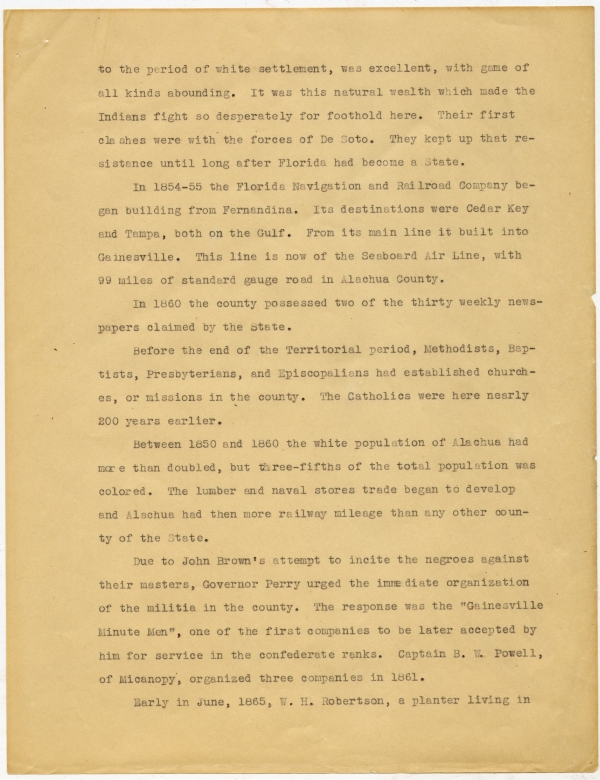


 Listen: The World Program
Listen: The World Program